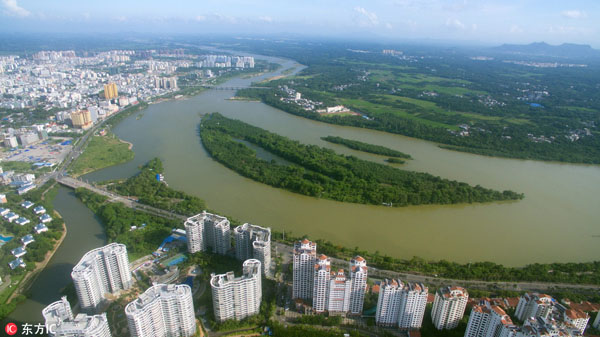 |
|
New apartments are built in Qionghai, South China's Hainan province, July 23, 2016. [Photo/IC] |
China recently announced that by 2020 about 1000 selected towns will be turned into environmentally, culturally and economically dynamic hubs, which would create new jobs and offer livable habitats.
Given the fact that China has up to 3,000 counties and 18,000 towns and boasts of its lasting civilization and diversity of cultures, this decision still appears conservative. It is also time-constraining to craft a town into a heritage place within four or five years.
However, this decision is encouraging simply because it indicates Beijing's new policy of guiding the urbanization process, which in the past mainly focused on construction of cities of varying sizes. The move indicates Beijing's determination to value and explore the richness of Chinese culture and history by protecting natural and historic treasures across the land.
On the other hand, assuming an average minimum of 100 million dollars for heritage protection, infrastructure construction, entertainment and hospitality expansion in each town, the scale of investment will be enormous amid, a boost amid the current economic downturn pressures.
So this is definitely a new engine for China to revive its economy. However much-needed cautions is vital. China must avoid the mistakes we have made in expanding cities in last two or three decades, which was the golden period for urbanization. In the previous fast-paced development, not many projects in cities can be called heritages to be handed down for future generations.
Such mistakes should not be repeated in this round of township expansion. To help achieve this, China should learn from European countries and forge dynamic partnerships to incorporate European experience into practice in China. Of course, that doesn't mean simply copying European architectural styles as many Chinese cities have done previously.
On an urgent note, China should strengthen legislation on heritage protection at the town level. It should be mandatory that the historic buildings, bridges and non-material heritages should be projected and lakes, forests and rivers should be conserved.
This should not only be applied to the 1000 selected towns but it should be made a national campaign to protect all the 18000 towns and their neighborhoods.
Meanwhile, theme-based planning experience can be borrowed from Europe. For example, the towns along the major river valleys such as Danube, Rhine, Seine, and Loire have already become agricultural and industrial centers as well as tourist magnets.
China is developing the Yangtze River, the longest in the country, into a new economic belt. The towns along it and its tributaries can be an example of learning from Europe. It should be easy to achieve as more than 600 pairs of sister city partnership have already been forged between China and Europe. And township construction along river valley can be one of major areas of cooperation.
On the basis of protection and well planning, the towns should be expanded. Of course, we need modern facilities such as museums, theaters, indoor or outdoor swimming pools, train and bus stations, and parking places. But a principle must be observed that all the new buildings should be consistent in carrying on historic memories of local styles.
It should also be possible to prevent coal-burning and encourage cycling or electric public transport in all of these 1000 towns. Or at least turn them into carbon-neutral centers. These should be new ideas to think about.
Basically, those towns and places around them can be agricultural parks. Caution should be exercised over attracting industrial plants. But two areas should be highly recommended.
One is holiday resort and aging care centers. As China's living standards are increasing, the demands of holiday spending and leisure will be soaring.
And those who are retiring from bustling cities are also choosing quiet towns to enrich their lives. Such demand should be met during township construction.
Another area should be plans for university or academic institution relocation. Most of China's universities and academic facilities are in crowded cities. While many are prioritizing their functions, some universities should be moved to small towns.
If such advice is followed then hopefully China's Cambridge and Oxford will be appearing in the first 1000 towns. On top of that, industrial and high-tech parks can be gradually formed along the towns.
Such is also process to bring value-added benefits for locals. Of course, Rome was not built in a day and in turning China's towns into stunning attractions, four or five years is not enough.
This coulod well turn out to be one of the major socio-economic transformation trends for China in the coming twenty years.
The author is deputy chief of China Daily European Bureau.
fujing@chinadaily.com.cn